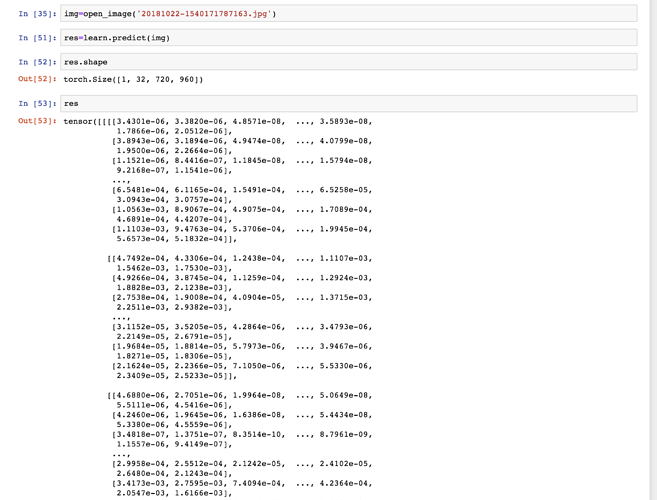I want to implement a NN from scratch using the MNIST dataset.
I am using ImageDataBunch to load the files. But for pedagogical reasons I want to the 28x28 input to be flatten in (784,). How can I do that using fastai loading features?
More a python question but related to fastai repo.
I have data = ImageDataBunch.from_folder(…)
Now I successfully get:
data.c >>> 2031
where does data (a ImageDataBunch) inherit this property from?
dir(data) does not show c or even classes
It’s super_class (i.e class DataBunch) also does not have this property or method
Just trying to learn to figure out how to work with this dynamic world of data_block api 
Hi all.
Have spent quite some time but still can’t figure out why learn.get_preds throws an error that:
“index 68000 is out of bounds for axis 0 with size 68000”. Has anyone faced the same issue? Here is a gist for the notebook:
Here are the specs of the Imagedatabunch. Look the same as for MNIST dataset (size of test x ≠ size test y).
Cheers,
Andrei
if someone faced the same issue - > make sure the size of validation set is ≥ test set. Helped me
learn.model = torch.nn.DataParallel(learn.model)
worked for me for Resnet models, but when I try the same with
learn = language_model_learner(data_lm, pretrained_model=URLs.WT103, drop_mult=0.3)
with week 4 notebook, I get an error when training:
'DataParallel' object has no attribute '"reset"'
Any suggestions how to fix it?
--------------------------------------------------------------------------- AttributeError Traceback (most recent call last) <ipython-input-13-31b16a16d38f> in <module> ----> 1 learn.fit_one_cycle(1, 2e-2, moms=(0.8,0.7)) ~/.conda/envs/fastaiv1/lib/python3.6/site-packages/fastai/train.py in fit_one_cycle(learn, cyc_len, max_lr, moms, div_factor, pct_start, wd, callbacks, **kwargs) 18 callbacks.append(OneCycleScheduler(learn, max_lr, moms=moms, div_factor=div_factor, 19 pct_start=pct_start, **kwargs)) ---> 20 learn.fit(cyc_len, max_lr, wd=wd, callbacks=callbacks) 21 22 def lr_find(learn:Learner, start_lr:Floats=1e-7, end_lr:Floats=10, num_it:int=100, stop_div:bool=True, **kwargs:Any): ~/.conda/envs/fastaiv1/lib/python3.6/site-packages/fastai/basic_train.py in fit(self, epochs, lr, wd, callbacks) 160 callbacks = [cb(self) for cb in self.callback_fns] + listify(callbacks) 161 fit(epochs, self.model, self.loss_func, opt=self.opt, data=self.data, metrics=self.metrics, --> 162 callbacks=self.callbacks+callbacks) 163 164 def create_opt(self, lr:Floats, wd:Floats=0.)->None: ~/.conda/envs/fastaiv1/lib/python3.6/site-packages/fastai/basic_train.py in fit(epochs, model, loss_func, opt, data, callbacks, metrics) 92 except Exception as e: 93 exception = e ---> 94 raise e 95 finally: cb_handler.on_train_end(exception) 96 ~/.conda/envs/fastaiv1/lib/python3.6/site-packages/fastai/basic_train.py in fit(epochs, model, loss_func, opt, data, callbacks, metrics) 78 for epoch in pbar: 79 model.train() ---> 80 cb_handler.on_epoch_begin() 81 82 for xb,yb in progress_bar(data.train_dl, parent=pbar): ~/.conda/envs/fastaiv1/lib/python3.6/site-packages/fastai/callback.py in on_epoch_begin(self) 197 "Handle new epoch." 198 self.state_dict['num_batch'] = 0 --> 199 self('epoch_begin') 200 201 def on_batch_begin(self, xb:Tensor, yb:Tensor, train:bool=True)->None: ~/.conda/envs/fastaiv1/lib/python3.6/site-packages/fastai/callback.py in __call__(self, cb_name, call_mets, **kwargs) 185 "Call through to all of the `CallbakHandler` functions." 186 if call_mets: [getattr(met, f'on_{cb_name}')(**self.state_dict, **kwargs) for met in self.metrics] --> 187 return [getattr(cb, f'on_{cb_name}')(**self.state_dict, **kwargs) for cb in self.callbacks] 188 189 def on_train_begin(self, epochs:int, pbar:PBar, metrics:MetricFuncList)->None: ~/.conda/envs/fastaiv1/lib/python3.6/site-packages/fastai/callback.py in <listcomp>(.0) 185 "Call through to all of the `CallbakHandler` functions." 186 if call_mets: [getattr(met, f'on_{cb_name}')(**self.state_dict, **kwargs) for met in self.metrics] --> 187 return [getattr(cb, f'on_{cb_name}')(**self.state_dict, **kwargs) for cb in self.callbacks] 188 189 def on_train_begin(self, epochs:int, pbar:PBar, metrics:MetricFuncList)->None: ~/.conda/envs/fastaiv1/lib/python3.6/site-packages/fastai/callbacks/rnn.py in on_epoch_begin(self, **kwargs) 16 17 def on_epoch_begin(self, **kwargs): ---> 18 self.learn.model.reset() 19 20 def on_loss_begin(self, last_output:Tuple[Tensor,Tensor,Tensor], **kwargs): ~/.conda/envs/fastaiv1/lib/python3.6/site-packages/torch/nn/modules/module.py in __getattr__(self, name) 523 return modules[name] 524 raise AttributeError("'{}' object has no attribute '{}'".format( --> 525 type(self).__name__, name)) 526 527 def __setattr__(self, name, value): AttributeError: 'DataParallel' object has no attribute 'reset'
Maybe someone from fastai team could help. It seems, like test creation in v1.0.24 is broken (if you add a test with add_test or add_test_folder). Constructor of ImageItemList takes a y length for test from validation.
My workaround was to create train and valid the standard way:
src = (ImageItemList.from_csv(path, 'train.csv', folder='train_combined', suffix='.png') .random_split_by_pct(0.2) .label_from_df(sep=' '))
And assign test manually like this:
test_item_list = ImageItemList.from_folder(path/'test_combined')
src.test = test_item_list.label_from_list(labels=['0']*len(test_item_list))
Hope it could help someone trying to predict on test))
Anyway it would be nice to hear from fastai developers the correct way of preparing test set.
You can convert the grey-scale image into a "pseudo"colour image by copying the one channel three times. and use the resulting three channel image as input.
that dsnt give the look of gray scale image i guess… I compared it actual gray and psuedo one … can i request you give your method once…
Code snippet (do not remember where I got this from):
w, h = grey_im.shape[:2]
pseudo_im = np.zeros((w, h, 3), dtype=np.uint8)
pseudo_im[:, :, 0] = spec
pseudo_im[:, :, 1] = spec
pseudo_im[:, :, 2] = spec
Grey and “pseudo” colour image look the same.
It works for me on an AWS EC2 P3, but not on Sagemaker.
You can incorporate the flatten operation with the torch view function in your NN forward function:
x = x.view(-1,784)
If you build your NN with nn.Sequential you can use the view function in a Lambda class.
I am currently going through some Pytorch tutorials myself to get going with the principles. 
I working with protein, version 1.024, test assign without problem.
Problem with dataset items - they are Image objects, so i cant access to item names, so cant understand how prepare submission file…
I am also facing the similar issue with datablock API. I used the standard API and it is working fine
data = ImageDataBunch.from_csv(path,folder=‘train-images’,valid_pct=0.2, csv_labels=‘labels.csv’,
ds_tfms=get_transforms(), size=256,bs=16,padding_mode=‘zeros’,num_workers=0)
Did you try to the same random_seed(42) for example for the two APIs? Possibly the random split to train and val is causing error or not? Due to some classes not being in both train and valid…
No I have not tried random seed .Let me try with random seed.
Thanks,
Ritika
If you grab the .items attr instead then you’ll find the filenames there.
Can somebody please tell me how to display the output of the unet?
I did a learn.predict on an img. I assume there is some helper function to map from the 32 code dimensions to color values?
print what you have in the output, so we can help
You can use argmax as we discussed in class to get the class indexes from that.

